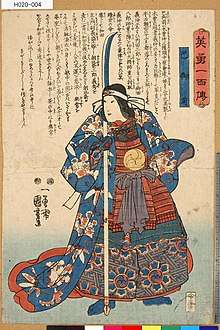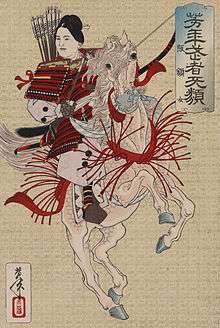Onna-bugeisha
Onna-bugeisha (女武芸者, "female martial artist") was a type of female warrior belonging to the Japanese nobility. These women engaged in battle alongside samurai men mostly in times of need. They were members of the bushi (samurai) class in feudal Japan and were trained in the use of weapons to protect their household, family, and honour in times of war. Significant icons such as Tomoe Gozen, Nakano Takeko, and Hōjō Masako are famous examples of onna-bugeisha.

Early history
Long before the emergence of the renowned samurai class, Japanese fighters were highly trained to wield a sword and spear. Women learned to use naginata, kaiken, and the art of tantojutsu in battle. Such training ensured protection in communities that lacked male fighters. One such woman, later known as Empress Jingū (c. 169–269 AD), used her skills to inspire economic and social change. She was recognized as the onna bugeisha who led an invasion of Korea in 200 AD after her husband Emperor Chūai, the fourteenth emperor of Japan, was slain in battle.[1]
According to the legend, she miraculously led a Japanese conquest of Korea without shedding a drop of blood. Despite controversies surrounding her existence and her accomplishments, she was an example of the onna bugeisha in its entirety. Years after her death, Jingū was able to transcend the socioeconomic structures that were instilled in Japan. In 1881, Empress Jingū became the first woman to be featured on a Japanese banknote. Designed to stop counterfeiting, her image was printed on oblong paper.[1]

Kamakura Period
The Genpei War (1180–1185) marked the war between the Taira (Heike) and Minamoto (Genji) clans; two very prominent and powerful Japanese clans of the late-Heian period. The epic The Tale of the Heike was composed in the early 13th century in order to commemorate the stories of courageous and devoted samurai.[2] Among those was Tomoe Gozen, servant of Minamoto no Yoshinaka of the Minamoto clan. She assisted Yoshinaka in defending himself against the forces of his cousin, Minamoto no Yoritomo, especially during the Battle of Awazu on February 21, 1184.
In The Tale of the Heike, written at the beginning of the 14th century, she was described:
... especially beautiful, with white skin, long hair, and charming features. She was also a remarkably strong archer, and as a swords-woman she was a warrior worth a thousand, ready to confront a demon or a god, mounted or on foot. She handled unbroken horses with superb skill; she rode unscathed down perilous descents. Whenever a battle was imminent, Yoshinaka sent her out as his first captain, equipped with strong armor, an oversized sword, and a mighty bow; and she performed more deeds of valor than any of his other warriors.[3]
Although she was not proven to be a historical figure, Tomoe Gozen has impacted much of the warrior class, including many traditional Naginata schools. Her actions in battle also received much attention in the arts plays such as Tomoe no Monogatari and various ukiyo-e. As time passed, the influence of onna-bugeisha saw its way from paintings to politics.
Another famous female general of the Genpei War was Hangaku Gozen. While Tomoe Gozen was an ally of the Minamoto clan, Hangaku allied with the Taira clan. The existence of these two prominent female generals confirms that the status of women during this time was still less unequal than future periods. Several other women are supposed to have acted as samurai during this period, but many of them have been omitted from history.
In ages past, it was more common to see women become reigning empresses, this would change in the future during the Meiji restoration. Throughout Japanese history, women, while not generally becoming de jure chiefs of a samurai clan, several de facto ruled their clans.
Chancellor Tōin Kinkata (1291-1360) once mentioned in his journal Entairyaku (園太暦) a “predominately female cavalry” without giving further explanations. With few descriptions he induced: "there is a lot of female cavalry", as he noted that they were from western Japan, it may imply that women from the west, regions far from the big capital cities, were more likely to fight in battles. Even if we can’t know the truth about this particular case, female cavalry fighting on the battlefield remains within the realm of possibilities. Women forming cavalry forces were also reported during the Sengoku Period (c. 1467 – c. 1600).[4]
After the Heike were thwarted towards the western provinces of Japan, the Kamakura shogunate (1185–1333) was soon established under the rule of Minamoto no Yoritomo. After he passed, his wife, Hōjō Masako, acting in the early years of the Hōjō regency, became the first onna-bugeisha to be a prominent player in politics. Masako became a Buddhist nun, a traditional fate of samurai widows, and continued her involvement in politics, influencing the fates of her sons Minamoto no Yoriie and Minamoto no Sanetomo, the second and third shōgun, and of the Hōjō faction at the shōguns' court.[5]
Through the collective efforts of Masako and a few political puppets, laws governing the shōgun's court in the early 13th century allowed women equal rights of inheritance with fraternal kin. Even though the primary role of women in ancient Japan continued to be the support to their family and their husbands, they acquired a higher status in the household. These laws also allowed Japanese women to control finances, bequeath property, maintain their homes, manage servants, and raise their children with proper, loyal, samurai upbringing. Japanese women were also expected to defend their homes in times of war.

Sengoku Period
During the Ashikaga Shogunate, due to tensions between the shogunate retainers, Japan goes to war again. In 1460, when shogun Ashikaga Yoshimasa abdicated his position to his younger brother Ashikaga Yoshimi, Hino Tomiko (Yoshimasa's wife) was strongly against this decision. Tomiko sought political and military support to rule as regent until the birth of her son, she secured the support of Yamana Sōzen and other leaders of powerful samurai clans. Then she went to war against Yoshimasa and his supporters, especially the Hosokawa clan. This dispute for succession started the Ōnin War (1467-1477) and led to the begin of the Sengoku period.[6]

In the Azuchi–Momoyama period several daimyos took charge of their own affairs and fought against each other by territory, women of noble clans and even peasant women members of Ikkō-ikki, Ikkō-shu, Saika Ikki and others Ikki sects went to the battlefields. In 1569, Ichikawa no Tsubone, the wife of a Mori family retainer from western Japan. When her husband was absent from the campaign, she assumed responsibility for the defense of Konomine castle with her armed ladies-in-waiting. Attacks on the yamashiro (the mountaintop castles), the characteristic fortress of the daimyo, have provided many unwanted opportunities for women to engage in defense and suffer the ultimate sacrifice if the castle falls.
Women participated in battles until the unification of Japan by Toyotomi Hideyoshi. In 1591 several women defended Kunohe Castle even when it was on fire in the Kunohe Rebellion. After Hideyoshi's death, his concubine Yodo-dono took over the de facto leadership of the Toyotomi clan and in 1614 she and her son, Hideyori, led a rebellion against the Tokugawa shogunate. In 1615, when Tokugawa Ieyasu attacked Osaka castle again, Yodo-dono and her son committed suicide in the flames of Osaka castle. Suicide inside a burning castle may have been the last act of loyalty to a samurai-class woman.[7]
Evidence of female participation in battles
During the Sengoku period there are several accounts of women actively on the battlefield, such as the case of Myorin who inspired the people to fight against 3,000 Shimazu soldiers, Kaihime who fought against the Toyotomi clan in the Siege of Oshi (1590), Onamihime who became the representative leader of the Nikaidō clan and fought in various battles against her nephew Date Masamune. Akai Teruko, who became famous for fighting until she was 76 years old and became known as ''The Strongest Woman in the Warring States Period''. The heroic Tsuruhime, who is said to be the ''Joan of Arc of Japan'', is one of the several examples of how the Onna-bugeisha played a crucial role in japanese history.[7]
.jpg)
Japanese women were educated to become wives and mothers, although most women knew about politics, martial arts and diplomacy, they were not allowed to succeed clan leadership. However, there were exceptions, Ii Naotora took over the clan leadership after the death of all men of the Ii family, her efforts as a leader made her clan independent and she became a Daimyō. There were many noble women with great political influence in their clans, even becoming the de facto leader. An acceptable example of women who became known as ''onna daimyo'' (female landlord) are Jukei-ni and Toshoin. Both women acted, for a long period, as rulers of their respective feuds, even though they were not considered heirs.
In the 16th century there were units consisting only of women, as was the case of Ikeda Sen who led 200 women musketeers (Teppo unit) in the Battle of Shizugatake and Battle of Komaki-Nagakute.[8] Otazu no kata fought alongside 18 armed maids against Tokugawa Ieyasu's troops.[9] Ueno Tsuruhime led thirty-four women in a suicidal charge against the Mōri army.[10] Tachibana Ginchiyo, leader of the Tachibana clan fought with her female troops in the Kyushu Campaign (1586) and in the Siege of Yanagawa (1600) she organized a resistance formed by nuns against the advance of the Eastern Army.[11] These warrior women are presumed to be a minority, but recent studies show that women have always been on the battlefield. The samurai women were not unique to the castle's defense, but also traveled with other men to conquer territories.
In 1580, a woman from the Bessho clan joins a rebellion against Toyotomi Hideyoshi during the Siege of Miki. Her husband Bessho Yoshichika was one of the leaders of the rebellion and she plays a key role during the siege, allying herself with the Mori clan. The rebellion lasted three years, until Bessho Nagaharu surrendered the castle to Hideyoshi, Lady Bessho commits suicide shortly after. In 1582, Oda Nobunaga launched a final attack on the Takeda clan, a series of battles known as the Battle of Tenmokuzan. Oda Nobutada (son of Nobunaga) led 50,000 soldiers, against 3,000 allies of the Takeda clan during the Siege of Takato castle. During this battle, it is recorded in the compilation of chronicles from the Oda clan, Shinchō kōki, that a woman from the Suwa clan defies Nobutada's forces. The fact that these women have no names recorded in history reiterates the argument that many reports of samurai women participating in battles have been omitted and lost over the years.
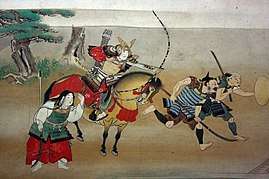
During this era, the existence of female Ninjas (Kunoichi) is dated, their training differed from the training given to male ninjas, although they also had a core in common as they trained in taijutsu, kenjutsu, ninjutsu skills. A historically accepted example is Mochizuki Chiyome, a 16th-century noble descendant who was commissioned by warlord Takeda Shingen to recruit women to create a secret network of hundreds of spies.[12]
It is believed that many more women participated in battles than those written in historical records. For example, DNA tests on 105 bodies excavated from the Battle of Senbon Matsubaru between Takeda Katsuyori and Hojo Ujinao in 1580 revealed that 35 of them were women. Other excavations were made in areas where battles took place away from castles,. Japanese archeologist Suzuki Hiroatsu explains that it is common to find bones of women or children where castle sieges took place, since they usually participated in the defense. He, however stresses the fact that there was no castle on this site and concludes that “these women came here to fight and to die” and could have been part of the army. According to these studies, it shows that 30% of battle corpses away from castles were women. Excavations conducted on other battle sites across Japan gave similar results. According to Stephen Turnbull, the details of the excavation confirm the Onna-bugeishas were almost certainly present in the battlefields.[7]
Edo Period and beyond

Because of the influence of Edo neo-Confucianism (1600–1868), the status of the onna-bugeisha diminished significantly. The function of onna-bugeisha changed in addition to their husbands. Samurai were no longer concerned with battles and war, they were bureaucrats. Women, specifically daughters of most upper class households, were soon pawns to dreams of success and power. The roaring ideals of fearless devotion and selflessness were gradually replaced by quiet, passive, civil obedience.
Travel during the Edo period was demanding and unsettling for many female samurai (because of heavy restrictions). They always had to be accompanied by a man, since they were not allowed to travel by themselves. Additionally, they had to possess specific permits, establishing their business and motives. Samurai women also received much harassment from officials who manned inspection checkpoints.

The onset of the 17th century marked a significant transformation in the social acceptance of women in Japan. Many samurai viewed women purely as child bearers; the concept of a woman being a fit companion for war was no longer conceivable. The relationship between a husband and wife could be correlated to that of a lord and his vassal. "Husbands and wives did not even customarily sleep together. The husband would visit his wife to initiate any sexual activity and afterwards would retire to his own room".[13]
Although women learned exclusively Naginata handling techniques, some women broke traditionalism and learned different techniques such as Kenjutsu. Sasaki Rui, Chiba Sanako and Nakazawa Koto are examples of women who became prominent swordswomen in Edo period. During this time, female-led kenjutsu schools become commonplace, although traditionally the leadership of these schools is inherited patrilinely.
In 1868, during the Battle of Aizu, a part of the Boshin War, Nakano Takeko, a member of the Aizu clan, was recruited to become leader of a female corps Jōshitai (娘子隊 Girls' Army). who fought against the onslaught of 20,000 soldiers of the Imperial Japanese Army of the Ōgaki Domain. Highly skilled at the naginata, Takeko and her corps of about 20 joined 3000 other Aizu samurai in battle. The Hōkai-ji in Aizubange, Fukushima province contains a monument erected in her honor. Less-celebrated but no less remarkable would be the efforts of Yamamoto Yaeko, Matsudaira Teru and Yamakawa Futaba, who served as fighter defending Aizuwakamatsu Castle during the Battle of Aizu. Yaeko would later be one of the first civil leaders for women's rights in Japan.
Weapons
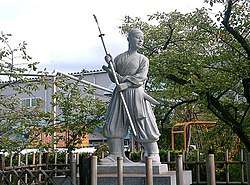
The most popular weapon-of-choice of onna-bugeisha is the naginata, which is a versatile, conventional polearm with a curved blade at the tip. The weapon is mainly favored for its length, which can compensate for the strength and body size advantage of male opponents.[14]
The naginata has a niche between the katana and the yari, which is rather effective in close quarter melee when the opponent is kept at bay, and is also relatively efficient against cavalry. Through its use by many legendary samurai women, the naginata has been propelled as the iconic image of a woman warrior. During the Edo Period, many schools focusing on the use of the naginata were created and perpetuated its association with women.
Additionally, as most of the time their primary purpose as onna-bugeisha was to safeguard their homes from marauders, emphasis was laid on ranged weapons to be shot from defensive structures.[14]
Legacy
The image of samurai women continues to be impactful in martial arts, historical novels, books and popular culture in general. Like the kunoichis (female ninja) and Geishas, the Onna-bugeisha's conduct is seen as the ideal of a Japanese women in movies, animations and TV series. In western, the Onna-bugeishas gained popularity when the historical documentary Samurai Warrior Queens aired on the Smithsonian Channel. Several other channels reprised the documentary. The 56th NHK taiga drama, Naotora: The Lady Warlord it was the first NHK drama where the female protagonist is the head of a samurai clan. The 52nd NHK taiga drama, Yae no Sakura focuses on Niijima Yae, a woman warrior who fought in Boshin War, this drama portrays Nakano Takeko, Matsudaira Teru and others onna-bugeishas. Other taiga dramas portray famous onna-bugeishas, Hōjō Masako and Tomoe Gozen are on the Yoshitsune (TV series), broadcast in 2005.
In Japan, Tomoe Gozen and Nakano Takeko influenced naginata schools and their techniques. Whether formed by men or women, these schools usually revere the Onna-bugeishas. During the annual Aizu Autumn Festival, a group of young girls wearing hakama and shiro headbands take part in the procession, commemorating the actions of Nakano and the Jōshitai (Girls' Army). Other important examples are Yamakawa Futaba and Niijima Yae, who become symbols of the struggle for Japanese women's rights. Some of the onna-bugeishas have become symbolic of a city or prefecture, Ii Naotora and Tachibana Ginchiyo are often celebrated at Hamamatsu and Yanagawa festivals respectively. The warrior nun Myorin, is celebrated in the Tsurusaki region of the Ōita city, Ōhōri Tsuruhime is the protagonist of various local folklore and festivals on Ōmishima island. Several other samurai-class women are celebrated in pop culture, commerce and folklore.
Famous Onna-bugeisha
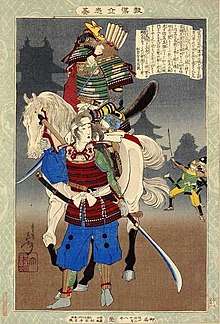
These are famous Onna-bugeisha with extraordinary achievements in history
- Empress Jingū: A Regent Empress who led the First Japanese invasion of Korea and many politicals events who impacted the Japanese history as well. Unlike other Japanese empresses and emperors, Jingu was a ruler who led military campaigns, work that was generally given to the Shōguns.
- Hōjō Masako: A political leader of the Kamakura Shogunate, she was a prominent figure in the Genpei War and many other events of Kamakura period. She was known as the ama-shōgun, or the ''nun-shōgun''.
- Nakano Takeko: The leader of the Jōshitai (Girls' Army), she participated in the Boshin war leading several women in a charge against the Imperial forces. Due to the reforms of the Meiji era, Takeko and the women of Jōshitai were one of the last samurai in history.
- Niijima Yae: She was one of the last samurai in history. She fought in the Boshin War and served as a nurse in the Russo-Japanese War and the Sino-Japanese War. Later she became a scholar and became one of the symbols of the struggle for women's rights. Yae was one of the first people to be decorated by the Meiji Empire.
- Tomoe Gozen: A extraordinary woman warrior who fought in conflicts that led to the first shogunate in Japan. Her legacy influenced several generations of samurai.
- Yodo-dono: A noble woman who was the castellan of Yodo castle and later became the real head of Osaka castle. She led many political events after the death of her husband, Hideyoshi. As guardian of Hideyori (Hideyoshi's son), she challenged the Tokugawa clan, thus leading the Siege of Osaka, the last battle of the Sengoku period that ends the war period for the next 250 years.
Honorable mentions
- Akai Teruko
- Yamakawa Futaba
- Ashikaga Ujinohime
- Tsuruhime
- Tachibana Ginchiyo
- Kaihime
- Ii Naotora
- Myorin
- Hangaku Gozen
- Komatsuhime
- Maeda Matsu
- Nakazawa Koto
- Sasaki Rui
- Lady Ichikawa
- Ikeda Sen
- Matsudaira Teru
- Miyohime
- Otazu no kata
- Onamihime
- Lady Otsuya
- Ueno Tsuruhime
- Katakura Kita
- Fujishiro Gozen
- Kamehime
- Katō Tsune
- Kushihashi Teru
- Myōki
- Numata Jakō
- Oni Gozen
- Okaji no Kata
- Okyō
- Omasa
- Lady Shirai
- Yuki no Kata
- Seishin-ni
- Tōshōin
- Jinbo Yukiko
- Chiba Sanako
References
- History of Japanese. Bank of Japan 1996–2009 Archived 2007-12-14 at the Wayback Machine
- McCullough, Helen (1988). The Tale of the Heike. Stanford, CA: Stanford UP. p. 6.
- Women Warriors of Japan: Early History
- "園太暦 4、305頁". Retrieved 2018-07-25.
- Hōjō Masako
- "Hino Tomiko". Daijirin. Archived from the original on 2009-08-04.
- Turnbull, Stephen (2012-01-20). Samurai Women 1184–1877. Bloomsbury Publishing. ISBN 9781780963334.
- 荒木祐臣 (1978). 備前藩幕末維新史談 (in Japanese). 日本文敎出版.
- "武家事紀. 上巻 - 国立国会図書館デジタルコレクション". dl.ndl.go.jp. Retrieved 2019-05-27.
- Toler, Pamela D. (2019-02-26). Women Warriors: An Unexpected History. Beacon Press. ISBN 9780807064320.
- "高橋・立花家の女性". ww2.tiki.ne.jp.
- Thomas A. Green, Martial Arts of the World (2001), p. 671.
- Women Warriors of Japan: The Edo Period, an Enforced Peace
- Women Warriors of Japan: The Edo Period, an Enforced Peace
Sources
- Szczepanski, K. (2009). Samurai Women of Japan. Library of Congress Prints Collection. About.com: Asian History. 3 December 2009.
- Beasley, W. G. (1999). The Japanese Experience: A Short History of Japan. University of California Press.
- Amdur, Ellis. (2009). Women Warriors of Japan: The Role of Arms-Bearing Women in Japanese History. Koryu Books, 2009.
- Jansen, Marius B. (2000) The Making of Modern Japan. The Belknap Press of Harvard University Press 2000
- Yamakawa Kikue; trans Nakai, Kate Wildman (2001) Women of the Mito Domain: Recollections of Samurai Family Life. Stanford University Press 2001
